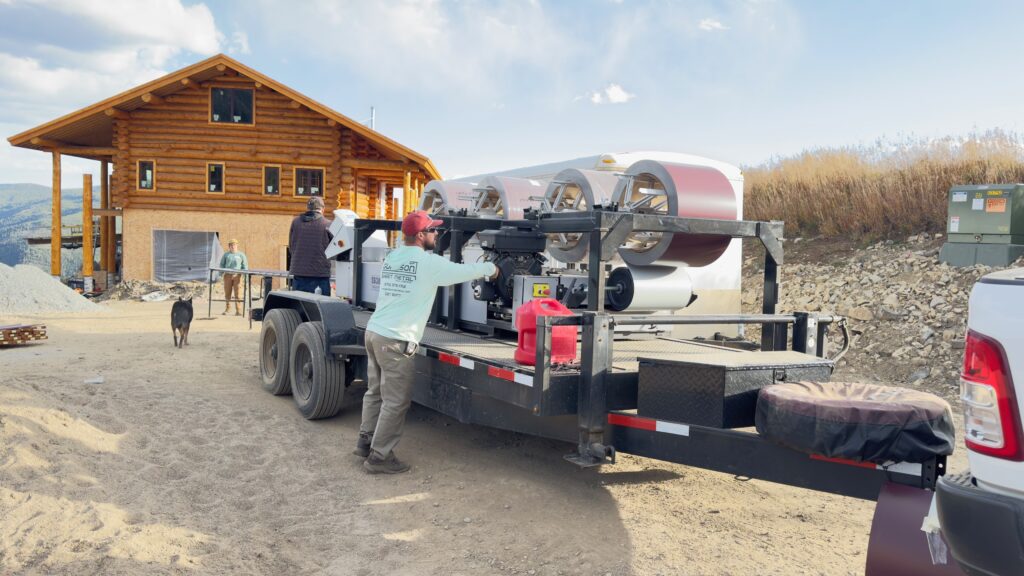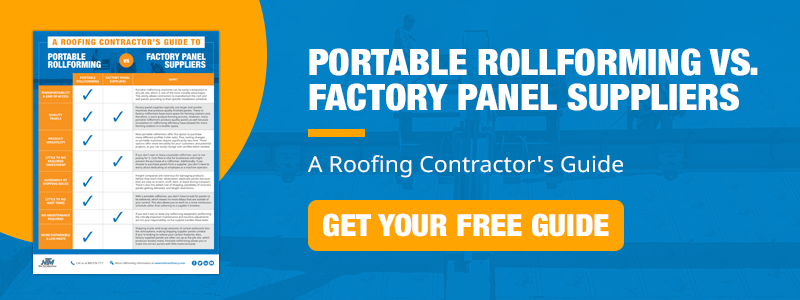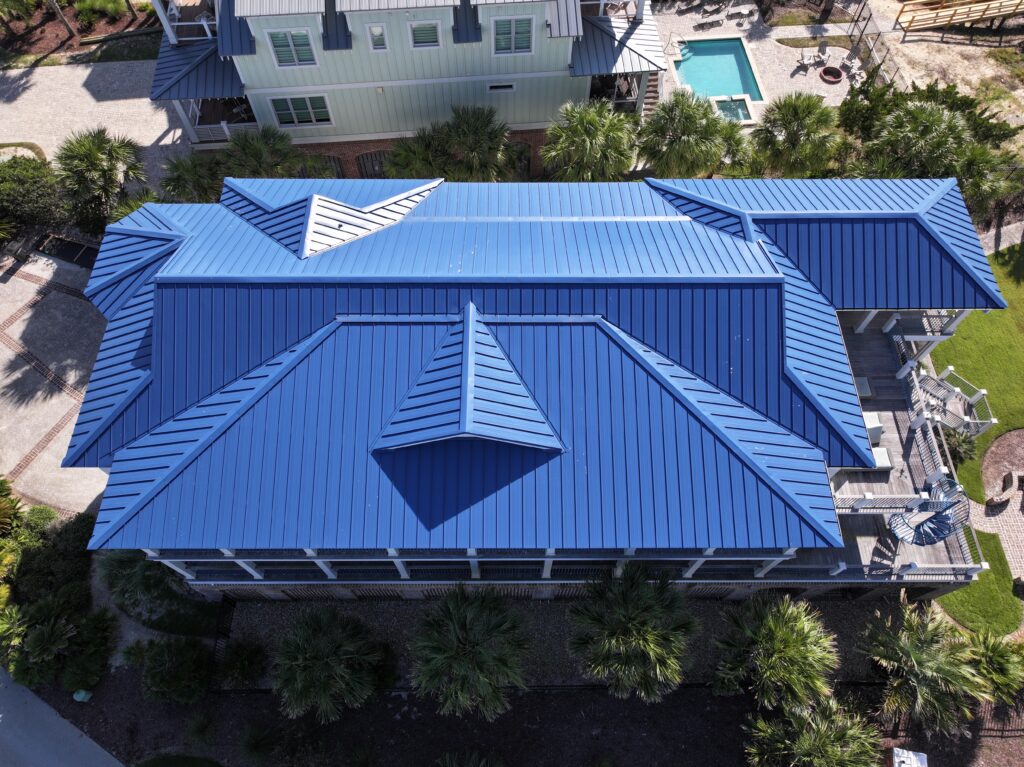What is Sustainability When it Comes to Portable Rollforming?
Sustainability has generated buzz in every industry, from urban planning to economics to agriculture. When it comes to the environment, sustainability generally means using resources—like energy, water, and raw materials—in a way that meets current needs without using them up at the expense of future generations. It’s about balancing economic growth and human development with the preservation of the environment.
As a business model, sustainability has many advantages. It can differentiate your operation from competitors who use more traditional methods and materials. It appeals to the eco-conscious customers, many of whom own high-end homes. It saves money as you’re not producing as much waste, and it builds your brand. If you want to be the go-to for anyone looking for a sustainable solution to their roofing or siding needs, you’re the business with that reputation.
From material to equipment, there’s a growing emphasis on minimizing waste, reducing energy consumption, and implementing eco-friendly practices wherever possible. At New Tech Machinery (NTM), we’ve been building quality portable rollforming metal roof, wall panel, and seamless gutter machines for over 30 years. Below, we’ll explore how eco-friendly portable rollforming equipment is shaping the future of roofing and siding.

Why Sustainability Matters in Metal Rollforming
Metal rollforming is often associated with durability, precision, and high-end roofing. It’s in line with conserving resources and protecting the environment.
But rollforming sustainability isn’t just good for the planet; it’s also good for business. It can help you:
- Attract Eco-Conscious Clients – Increasingly, building owners and architects are prioritizing green solutions.
- Reduce Operational Costs – Lower energy usage means smaller utility bills and less need for transportation and delivery.
- Build Your Brand – Branding your business sustainable can help differentiate you from the competition.

Sustainable Rollforming Benefits
- Maximized Coil Usage: Traditional asphalt roofing produces a lot of waste. Roofers cut off overhanging shingles during installation, and the old shingles generally go straight to the local landfill. Advanced rollforming technology precisely measures and cuts only what’s required according to the specs you enter into a computerized controller. By investing in machines with controllers like NTM’s UNIQ® Automatic Control System, you can reduce scrap to near-zero levels and save on coil costs.
- Material Recycling: One huge advantage of metals like steel and aluminum is that they can be recycled repeatedly without losing structural integrity. Any leftover material can be recycled too, cutting down on both waste and raw material costs. Also, metal coil is generally made of at least 25% recycled material.
- Energy Efficiency: Modern portable rollforming equipment is designed to run efficiently, using powerful but energy-saving motors and drive systems. Some facilities are even incorporating renewable energy sources, like solar panels, to power their operations, shrinking both their carbon footprint and energy costs. Rollforming doesn’t require heating up or cooling down the unit; it’s not high-impact or speed-driven. It’s a simple process that doesn’t require a lot of energy.
- Durable Equipment: Many products these days aren’t built to last, and consumers are incentivized to replace items that still work, like smartphones and laptops. Consumer Reports recommends replacing any appliance more than eight years old. That’s not true with a portable rollformer. With proper maintenance and care, NTM rollformers can last decades, keeping them out of landfills and junk yards.
- On-Site Rollforming: On-site rollforming can drastically reduce transportation costs and emissions by cutting out the need to move large sheets or panels from a manufacturing facility to the job site. Reduced transportation costs will also add cash to your bottom line.

LEED Certification
LEED (Leadership in Energy and Environmental Design) credits can benefit consumers who use eco-friendly building materials. LEED recognizes when a building or community uses materials to maximize energy efficiency and sustainability. LEED structures may qualify for rebates and other incentives and can increase property value.
Metal roofing benefits include:
• Tax incentives—Many states offer programs to encourage energy efficiency through LEED. Increasing energy efficiency is good for the environment and saves your customers money on energy bills. Since metal roofs keep buildings cooler in the summer, less demand on the HVAC system means more savings.
• Increases property value—A metal roof can increase a home’s value by up to 6%. For example, on a $500,000 home, that’s a $30,000 increase in value over a house with an asphalt shingle roof.
Insurance Benefits
In some areas, metal roofing is essential for securing home and building insurance. Fire-prone areas in western states like Colorado and California often require Class A fire-resistant roofs.
While no roof is completely fireproof, metal roofing carries a Class A fire rating, the highest designation by industry standards, which is why it’s recommended by FEMA in fire-prone areas. Metal deflects heat and prevents the spread of flames. Aluminum and zinc alloy roofs are more fire-resistant than galvanized steel or copper, but all carry Class A ratings and don’t require testing.
To receive a Class A rating, asphalt shingles must be tested to ASTM E108 or UL 790 standards and have a combustion temperature of over 650 degrees Fahrenheit.

The Bigger Picture
Sustainable metal rollforming goes beyond operating a few eco-friendly machines. It’s about building a culture of environmental responsibility, from design to distribution. This can mean collaborating with eco-responsible suppliers, choosing recycled materials, and continually looking for ways to refine and improve processes to help eliminate waste.
Who’s My Market?
Metal panel rollforming prevails when it comes to sustainable construction, as we’ve seen. Meanwhile, the push for greener building materials and methods continues to grow. By investing in efficient machinery, cutting back on waste, and adopting sustainable manufacturing practices, contractors and manufacturers can help ensure that metal construction remains a viable—and eco-friendly—option for home and business owners.
However, not everyone can cover the higher cost of metal. You’ll have to locate the demographic that’s best equipped to finance a metal roof. For example, higher-end homes and buildings and homes in rural areas are more likely to lean towards metal roofing and siding. Many residential areas will opt for asphalt shingles given the cost.
Metal also offers other sustainability advantages. Due to its Class A fire rating, it has become popular in areas prone to wildfires. It also handles snow loads efficiently and can better withstand severe weather than most traditional materials.
Fabricating panels on-site with a portable rollformer gives you the opportunity to establish a sustainable business and build a niche market.
For information on NTM rollforming products, contact us.

